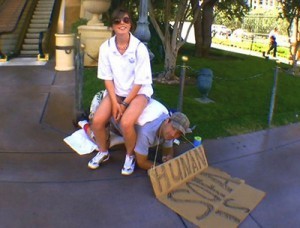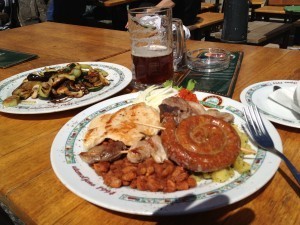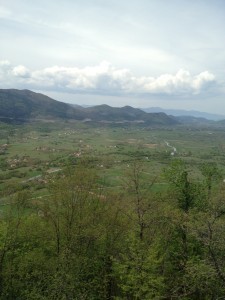Rolf Potts's Blog, page 94
May 18, 2012
Indie Flight Hacking from BootsnAll
Vagablogging :: Rolf Potts Vagabonding Blog
When you’ve taken the plunge and went from that dreaming stage to the actual planning stage of a RTW trip, it can be overwhelming to consider all the possibilities. I know when my wife and I first started planning our RTW trip, we (wrongly) assumed we would be able to go everywhere. For someone whose longest trip up until then had been 3 weeks, a year seemed like forever.
But once you get into the nitty gritty of the planning stages, you quickly realize that while yes, you can visit all seven continents over the course of a year, there are some major deterrents for doing so. One, the cost. The more stops you add, the more expensive those flights become. Two, for many, the enjoyment of a trip like this is really getting the chance to dig into a culture by exploring it in depth. When you’re constantly on the move every few days, that makes it impossible to do so.
So how do you choose your destinations? What activities, cities, and places do you build a trip around? Recently, BootsnAll started a new series called Indie Flight Hacking. The idea behind these new articles is to get travelers new to the long-term travel game thinking. We want to help these new RTW planners by looking at real itineraries, giving some tips on how to plan around these itineraries, and make you think about all the important information that doesn’t automatically come to you your first time planning an extended trip.
The first Indie Flight Hacking article we published followed a simple, hub city RTW trip to New York, London, Delhi, and Bangkok. The great thing about this trip is the flexibility of it. By flying in and out of these few major hubs, you can get a plane ticket for a good price, and the overland possibilities from each city is endless. If you only have a short time (3-4 weeks), you can do it. If you want to expand it to 3, 6, 9, 12 months, you can do that, too.
The second article follows the route that my wife and I took on our RTW trip through popular backpacking regions of South America, New Zealand, SE Asia, and India. We even provided sample pricing for the flights (both the RTW ticketing options and the buy as you go option), as well as information on why we chose this route, how we chose the order in which we visited these places, and how we planned around things like weather, holidays, and high and low seasons.
For first-time planners of an extended trip, it’s helpful to get into the minds of the planner and see some real examples of trip itineraries. We realize that everyone has different preferences for what they want to get out of a trip like this, but we hope this provides a start. These itineraries can all be adapted to fit your specific wants and needs.
The next Indie Flight Hacking article will be published on Monday, May 12, and will highlight a trekking RTW trip.
What other types of trips would you like to see profiled on this series? Comment below to share your thoughts so we can help you get out on the road.
Wanna plan a trip around the world? Let the folks at BootsnAll help out!
Photo courtesy of the author and may not be used without permission.
Original article can be found here: Indie Flight Hacking from BootsnAll
Vagabonding Field Reports: Playing the Exchange Rate in Croatia
Vagablogging :: Rolf Potts Vagabonding Blog
Cost/Day: $50
It’s not everyday that you can visit the medieval section of Zagreb to see the cathedral, turn a corner, and find yourself at “The Museum of Broken Relationships,” winner of the 2011 “Most Innovative” European Museum Award. At first I thought it was a joke, but it’s an actual museum and judging by the crowds a very popular one. This striking dichotomy between the trendy and the classic is a major factor in why people visit Croatia. A few other reasons are the world-class beaches, friendly people, great exchange rate and sumptuous food.

A typical day in Zagreb is waking up around 9 a.m. and heading to one of the myriad cafes that line the narrow alleys in front of the cathedral. The open-air stalls begin to open for the day, and in May it’s a pleasant 65 degrees by mid-morning. An omelet and coffee will set you back about $4 including tip and tax.
Then it’s time for a stroll, there’s a lot of eating in Croatia so working up an appetite is a smart move. Continuing through the Upper Town, the Dolac Market appears. It is essentially a permanent farmer’s market on steroids. Hundreds of carts and stalls peddling eggs, produce, honey, olive oil and pretty much anything that can be grown or raised. This is the premier spot to pick up ingredients if you want to cook at home.
Speaking of home, a daily fully-furnished apartment rental in Zagreb is about $25 for an amazing location and a kitchen. I used airbnb.com and was not disappointed. There are also a bevy of top-notch hostels renting beds for about $10 a night.
If you’re ready for lunch, head on over to Mali Medi. This restaurant is a Zagreb fixture that sells traditional Croatian fare and home-made beer. A lunch is around $5 and could be anything from sausage and mashed potatoes to stew. A liter of their delicious beer is $3 and can be bought for take-away.
In the afternoon, Zagreb features Zrinjevac, a beautiful park in the center of the city. There are several prominent museums and art galleries, in addition to great outdoor activities. Locals love to head out to Medvenica Mountain for hiking or Jarun Lake for boating.
In the evening, the cafe culture of Zagreb is lively and cheap. Throngs of people drift through the streets, stopping for a coffee here and a glass of wine there. Most locals can speak some English and are very pleased to tell you exactly what they think of sports and politics and expect you to weigh-in with your views as well.
I myself had an interesting experience with a local waiter when trying to order a drink. Although his English was good, my Croatian consists of few words and many hand gestures. Something was bound to get lost in translation. I enquired if there were any good local beers I could try, he smiled broadly and said, “Oh yes, we have Pivo.” Assuming Pivo was the name of a local beer I ordered one and settled in. The beer came out and definitely did not say “Pivo” on the bottle. I asked if he had made a mistake and he shook his no and looked slightly perturbed. I decided to let it drop and sipped the watery beer. Most restaurants in Zagreb sign contracts with a beer company to sell only their brand and thus switching was not an option.
It was a few days later that I learned that Pivo is not a local brand, but in fact the Croatian word for beer. The waiter had been so happy about my order because apparently his restaurant had been saddled with a bad brand and I was the first to ever order it. I soon after resolved to learn the names of important food and beverage items in Croatian.
Zagreb is fantastic for dining and culture. The weather is great and the city beautiful. The only knock on Zagreb is that it is well inland and many head to Croatia for the beach, specifically the Dalmatian Coast. If this is you, then head for Split. Trains run four times a day from Zagreb and take about six hours.
One challenging thing about Croatia is navigating the streets when you first get to town. In Spain or France, the names may be foreign, but they at least look vaguely familiar and most people have some exposure to French and Spanish. For those with no background in Slavic languages, directions and street signs can be a bit tough at first. The nice thing about Zagreb is that the city center is relatively small and very walkable so most of the time you don’t have to worry about trams.
A new lesson that I learned is to take care of everything you can in a country with a favorable exchange rate while traveling. Basic things like getting a haircut, buying razorblades or finding a dress shirt are infinitely cheaper is some countries, so take advantage as you pass through.
Up next…Munich for brats and beer!
Original article can be found here: Vagabonding Field Reports: Playing the Exchange Rate in Croatia
Studying Stool Samples
Vagablogging :: Rolf Potts Vagabonding Blog
The first and only time I’ve had to shit in a cup was at the CIWEC clinic in Kathmandu, Nepal. It was nearly ten years ago and, as a newbie traveler, I didn’t yet have experience with dysentery—the awfulness of things exploding, simultaneously, out of nearly every orifice. When the friendly doctor asked me to “provide a stool sample,” something clicked in my mind. Of course. That’s how they diagnose these illnesses: they need to examine your turds.
These days I’m no longer an amateur when it comes to stomach bugs, and if I’m traveling to a high-risk place like Nepal or India, I treat my Ciprofloxacin pills with the same care as my passport. Because the stuff works like magic, and I never, ever want to give another stool sample.
I’ve been so pre-occupied with the fear of shitting in a cup that I haven’t given much thought to the doctors on the other end—the ones who look at what’s inside the cup. Until recently, that is. I came across a fascinating book, called “Travel Medicine: Tales Behind the Science,” featuring stories from heroic doctors who have dedicated their lives to studying stool samples.
Aside from learning new facts (“a shaken stool sample creates the sound of a marble rolling around”) and that diarrhea doctors have a sense of humor (one sent a crushed Baby Ruth bar mixed with water and red-streaked strips of paper towels to the lab for identification), there are true tales of medical discovery here. Like the story of the doctors at the CIWEC clinic, who, back in the 1980s, repeatedly observed an unidentified particle in patients’ stools that co-occurred with a sudden onset of cramps, diarrhea and nausea, followed by severe anorexia and fatigue. After six years of research, it was determined that they had found “the first new intestinal protozoal pathogen discovered in 70 years,” now known as Cyclospora.
If you’re interested in reading more about traveler’s diarrhea and obscure travel-related illnesses, check out the Journal of Travel Medicine, which publishes six issues a year. Articles include individual case studies—such as “Leptospirosis in a French Traveler Returning From Mauritius,” “Transient Facial Swellings in a Patient With a Remote African Travel History,” and “Perniosis in a Long-Distance Cyclist Crossing Mongolia”—as well as reports of large-scale surveys, like “Incidence and Impact of Travelers’ Diarrhea Among Foreign Backpackers in Southeast Asia: A Result From Khao San Road, Bangkok.”
My favorite article? The cleverly titled “New England Souvenirs,” which, as you may imagine, does not involve a shot glass embossed with the Boston skyline.
Original article can be found here: Studying Stool Samples
May 17, 2012
Summer Travel Work, Part I: Teaching ESL
Vagablogging :: Rolf Potts Vagabonding Blog
 It’s a fact that travel dreams begin to intensify when summer is around the corner. For me and most other inveterate travelers I know, every fiber is starting to vibrate with an anxious need to hatch a plan pack a bag, and head off to far-flung places. The passport sings to us, asking to be paroled out of the drawer it’s been kept in for months. The question is, where and how? Money is tight, and gas prices are pushing plane fares upward. There are still great deals to be found, of course, but this summer it’s especially important to find ways to supplement income during the travels.
It’s a fact that travel dreams begin to intensify when summer is around the corner. For me and most other inveterate travelers I know, every fiber is starting to vibrate with an anxious need to hatch a plan pack a bag, and head off to far-flung places. The passport sings to us, asking to be paroled out of the drawer it’s been kept in for months. The question is, where and how? Money is tight, and gas prices are pushing plane fares upward. There are still great deals to be found, of course, but this summer it’s especially important to find ways to supplement income during the travels.
Teaching ESL (English as a Second Language) can be a great way to meet people and get steady pay. Tutoring locals interested in gaining a better grasp of the most commonly used language in the world can lead to great friendships, not just a few more Euros or Yuan. Often the job comes with low pay but great opportunities to experience a culture, travel widely, and meet some fascinating people.
Your chances of obtaining a decent ESL summer teaching gig are good in Asia. China is hungry for teachers to instruct adults. Their exploding economy means many professionals are looking to acquire a stronger command of English in order to be more competitive in the global marketplace. Japan, Thailand, and Korea have a vibrant market also despite less powerful economies.
The garden spots of Europe, however, are a tougher gig to land. Thriving Prague is a hot ticket. Gorgeous, cheap, and fun, the historic city is inundated with American, British and Australian college students eager to spend the summer tutoring by day and living it up at night. Dozens of private schools cater to the ever-more-Western business set looking to bolster their English skills. More easy-to-land opportunities can be found in the less-glamorous Polish and Russian cities. Don’t be fooled by their lack of glam or dour-looking school buildings; these work-a-day cities offer great opportunities for growth. travel, and fun.
It can be frustrating trying to sort out your options. Some schools require teachers to possess a TEFL certificate, many do not. And some TEFL programs aren’t worth the paper your certificate is printed on despite their flashy websites.
If you’re on the search for ESL opportunities abroad, or have done it and want to share your insights and advice, please leave a comment for those interested in trying it!
Original article can be found here: Summer Travel Work, Part I: Teaching ESL
Playing the Exchange Rate in Croatia
Vagablogging :: Rolf Potts Vagabonding Blog
Cost/Day: $50
It’s not everyday that you can visit the medieval section of Zagreb to see the cathedral, turn a corner, and find yourself at “The Museum of Broken Relationships,” winner of the 2011 “Most Innovative” European Museum Award. At first I thought it was a joke, but it’s an actual museum and judging by the crowds a very popular one. This striking dichotomy between the trendy and the classic is a major factor in why people visit Croatia. A few other reasons are the world-class beaches, friendly people, great exchange rate and sumptuous food.
A typical day in Zagreb is waking up around 9 a.m. and heading to one of the myriad cafes that line the narrow alleys in front of the cathedral. The open-air stalls begin to open for the day, and in May it’s a pleasant 65 degrees by mid-morning. An omelet and coffee will set you back about $4 including tip and tax.
Then it’s time for a stroll, there’s a lot of eating in Croatia so working up an appetite is a smart move. Continuing through the Upper Town, the Dolac Market appears. It is essentially a permanent farmer’s market on steroids. Hundreds of carts and stalls peddling eggs, produce, honey, olive oil and pretty much anything that can be grown or raised. This is the premier spot to pick up ingredients if you want to cook at home.
Speaking of home, a daily fully-furnished apartment rental in Zagreb is about $25 for an amazing location and a kitchen. I used airbnb.com and was not disappointed. There are also a bevy of top-notch hostels renting beds for about $10 a night.
If you’re ready for lunch, head on over to Mali Medi. This restaurant is a Zagreb fixture that sells traditional Croatian fare and home-made beer. A lunch is around $5 and could be anything from sausage and mashed potatoes to stew. A liter of their delicious beer is $3 and can be bought for take-away.
In the afternoon, Zagreb features Zrinjevac, a beautiful park in the center of the city. There are several prominent museums and art galleries, in addition to great outdoor activities. Locals love to head out to Medvenica Mountain for hiking or Jarun Lake for boating.
In the evening, the cafe culture of Zagreb is lively and cheap. Throngs of people drift through the streets, stopping for a coffee here and a glass of wine there. Most locals can speak some English and are very pleased to tell you exactly what they think of sports and politics and expect you to weigh-in with your views as well.
I myself had an interesting experience with a local waiter when trying to order a drink. Although his English was good, my Croatian consists of few words and many hand gestures. Something was bound to get lost in translation. I enquired if there were any good local beers I could try, he smiled broadly and said, “Oh yes, we have Pivo.” Assuming Pivo was the name of a local beer I ordered one and settled in. The beer came out and definitely did not say “Pivo” on the bottle. I asked if he had made a mistake and he shook his no and looked slightly perturbed. I decided to let it drop and sipped the watery beer. Most restaurants in Zagreb sign contracts with a beer company to sell only their brand and thus switching was not an option.
It was a few days later that I learned that Pivo is not a local brand, but in fact the Croatian word for beer. The waiter had been so happy about my order because apparently his restaurant had been saddled with a bad brand and I was the first to ever order it. I soon after resolved to learn the names of important food and beverage items in Croatian.
Zagreb is fantastic for dining and culture. The weather is great and the city beautiful. The only knock on Zagreb is that it is well inland and many head to Croatia for the beach, specifically the Dalmatian Coast. If this is you, then head for Split. Trains run four times a day from Zagreb and take about six hours.
One challenging thing about Croatia is navigating the streets when you first get to town. In Spain or France, the names may be foreign, but they at least look vaguely familiar and most people have some exposure to French and Spanish. For those with no background in Slavic languages, directions and street signs can be a bit tough at first. The nice thing about Zagreb is that the city center is relatively small and very walkable so most of the time you don’t have to worry about trams.
A new lesson that I learned is to take care of everything you can in a country with a favorable exchange rate while traveling. Basic things like getting a haircut, buying razorblades or finding a dress shirt are infinitely cheaper is some countries, so take advantage as you pass through.
Up next…Munich for brats and beer!
Original article can be found here: Playing the Exchange Rate in Croatia
Travel the world for free? Possible, according to Michael Wigge
Vagablogging :: Rolf Potts Vagabonding Blog
Hitchiking, working our way around the world or couchsurfing are all good ways to save some money on the road, but being able to travel without spending anything has always seemed impossible to me. As Anna recently posted, we may get free flights with credit cards’ air miles; however, as far as I know, travelling without spending a single cent is a dream. And believe me, I am one who really stretches his pennies as only few would do.
 Let me tell you, I was wrong: I discovered that Michael Wigge, a German TV travel comedian, has actually succeeded. His efforts are documented in the self published book and DVD aptly titled “How to travel the world for free”. Check a video trailer here.
Let me tell you, I was wrong: I discovered that Michael Wigge, a German TV travel comedian, has actually succeeded. His efforts are documented in the self published book and DVD aptly titled “How to travel the world for free”. Check a video trailer here.
According to Wigge, as travelling 25.000 miles from Europe to Antarctica wasn’t challenging enough on a budget, he decided to attempt it without a single cent: as the book’s synopsis states, “on his journey, Michael immerses himself into fascinating subcultures, sleeps on the street with homeless people and nourishes himself with flowers”.
Michael’s trip is a story of determination and adventure: by crossing the Atlantic working on a container ship, being hosted by the Amish community in Ohio and reaching Antarctica employed as a luxury cruise’s crew member, it seems like he found the real recipe for free travelling around the globe.
Nevertheless, as this sounded too good to be true, I decided to reach him and ask a few clarifying questions.
First of all, why did he do this? Michael says that he mostly wanted to show other travellers how such an accomplishment is possible. “I decided to travel moneyless to Antarctica since it has always been my dream to let things behind me, including all worries about money… Antarctica was pretty much a dream for a long time, as normally it can only be reached paying a lot. I started planning this trip for almost a year, researching contacts and developing ideas how to travel for free”.
Michael supports the idea that, wherever you go, you will always be able to find help from good people: “I crossed eleven countries. My experiences where overall really good: people were willing to help me out in my special situation. The best example happened in Colombia: I knocked at a house’s door in Cartagena and directly asked for free accommodation. A family of 13 didn’t even bother to ask why I was in such a needy situation. They just offered me a place to stay, although their house was already super crowded…”
Of course, having no money to travel at all also put Michael in some challenging, nasty situations. He confesses that “the worst penniless situation happened in Las Vegas: as the tap water contains too much chlorine overthere, my lips got heavily burned. Consequently, in order to drink I had to resort to a used McDonald cup I fished out of the rubbish, refilling it at the restaurant. After a couple of days, I got caught by a Mc Donald’s worker!! It also sucked to sleep on Waikiki Beach, Honolulu and get some of my things stolen”.
Ok, yet another travel beggar, you may think. Instead, this answer led me to ask Michael how he managed to survive in such a world where money has, sadly, the uttermost importance. His answer is simple: of course, he had to work. Instead of money, however, he applied a concept which has been lost in the sands of time. “The principle is easy: always use the barter system”.
Barter was the way he got around the big life necessities such as food and accommodation. Michael gives some interesting suggestions, indeed: “I got free food in shops or restaurants in trade for a good story, floor cleaning or dish washing. This strategy worked 80% of the times. I also had a netbook with me and could use many free wi-fi networks and use Couchsurfing. Here, same strategy: I helped out in the household in trade for free accommodation. Lastly, I got free transport hitchhiking, working on a cargo ship across the Atlantic and on a luxury cruise ship from Ushuaia to Antarctica.”

And when he had to work for cash, the jobs he invented were some of the craziest and funniest I have ever heard from a traveller: “I was a Hill Helper, or better I pushed tourists up the steep hills of San Francisco for 1 US $. I also did Pillow Fighting by offering a decent fight for a dollar. 300 people joined me within a couple of days, and I earned enough money to fly from San Francisco to Costa Rica. I was also a Human Sofa: tired tourists could sit on my back in Las Vegas to relax for just a dollar. Moreover, I have been a butler for the German Ambassador in Panama: as I worked for the great man, he helped me buy a plane ticket to Colombia. The worst nightmare of a job though was working as a porter at Machu Picchu, to see it for free!!!”
Michael Wigge’s story may not be the ideal trip for most travellers and vagabonds, but clearly shows how resourcefulness, hard work and sharp wits can actually get us closer to our dreams. He concludes saying that he hopes his story would motivate other people to travel and explore the world, because his approach can be used by anybody, anywhere in the world. With or without money.
What do you think? Would you be able to travel the world for free as Micheal Wigge did and promotes? Please write your comments below. Hate him or love him, we surely have to check his book out.
Original article can be found here: Travel the world for free? Possible, according to Michael Wigge
May 16, 2012
Common sense: the best thing to take with you
Vagablogging :: Rolf Potts Vagabonding Blog
As independent travelers we discuss the best light weight gear or how to save pennies. But what about something that weights nothing and can’t be bought: common sense.
Like, pavement is more slippery when wet.
Rolling down the highway earlier today, I recalled a lesson my Grandfather taught my mother. “Drive five miles slower when it’s raining.” The charcoal sky began to pour and within moments even my windshield wipers–on high–did no good. Vehicles on all sides dropped from 70 to 40mph, and I decided to pull over and wait it out at a gas station. I got a cup of coffee and read another chapter of my book. Down pour turned to hail, then back to rain, and eventually subsided. A ways down the highway a wreaker truck was busy pulling several crumpled cars from a muddy meridian. I was thankful not to be one of them.
Yes, accidents do happen that aren’t always avoidable. But following your GPS when it tells you to drive into the Pacific Ocean is avoidable. Three tourists in Australia actually did that back in March. It was no accident. I’d say more like lack of common sense.

Car submerged in water Fairfax Media/Getty Images
Of course this doesn’t just apply to driving and isn’t a new concept. Thomas Paine wrote a pamphlet about it in the 1770’s. But it still seems people have a hard time using, “the basic level of practical knowledge and judgment that we all need to help us live in a reasonable and safe way”, as defined by the Cambridge Dictionary.
Vagabonding almost requires common sense. The more you apply, the richer the experience can be.
Original article can be found here: Common sense: the best thing to take with you
May 15, 2012
Airbnb: A better bet than hostel hopping?
Vagablogging :: Rolf Potts Vagabonding Blog
 Booking three weeks of European travel (on a budget) is a daunting task. One could spend an eternity burning the midnight oil on hostel aggregators, in a desperate search for half decent dorm bedrooms that (according to my recent searches) can run you 50-60 euro a night. 60 euro for a dorm bed? Not on this budget!
Booking three weeks of European travel (on a budget) is a daunting task. One could spend an eternity burning the midnight oil on hostel aggregators, in a desperate search for half decent dorm bedrooms that (according to my recent searches) can run you 50-60 euro a night. 60 euro for a dorm bed? Not on this budget!
And then I found Airbnb, the short term accommodation rental site that matches renters and rentees, all independent from professional hoteliers. It’s based on house sharing, not hostel booking, and I just finished reserving private apartments for a 3 week brother/sister jaunt through Paris, Bruges and Amsterdam. The rentals cost around 20 Euros less than the hip hostels in town, and while we won’t be part of late night backpacker comeraderie, I’m more than happy to give this airbnb model a chance. Coming home to a bohemian Parisian flat, a modern Dutch houseboat and a rustic Bruges farmhouse after long days of exploration will be welcome changes from dorm life. While some of my most treasured travel memories have been spent in hostels, I’m eager to discover whether Airbnb will make travel to expensive cities more affordable and, dare I say it, more enriching?
I did a bit more research about the house-sharing company and learn that Airbnb has over a million renters and hosts. We’re talking houses, apartments, villas, yachts, igloos, and even a treehouse or two. Headquartered in San Francisco, it was recently listed among the “next generation of multi billion dollar startups” by the New York Times.

The men behind the movement. Photo from Forbes
I’m thrilled to experience 3 weeks of apartment hopping, but not everyone is happy with the site’s incredible popularity. In 2011 they made $500 million, charging a 6-12% commission on each rental. People are asking: is it legal to rent out apartments for less than 30 days? Should airbnb start paying the same tourism taxes as big hotel chains? Is opening your home to strangers (and staying in the home of one) guaranteed to be safe?
The company is only a few years old, but founder Brian Chesky sees an enormous future ahead. He thinks of Airbnb as a “movement rather than a company.” The site “invites users to a time when hitchhiking wasn’t dangerous – when it was just fine to share anything with strangers because no one was all that strange.” I’ll be testing the waters in the next few weeks and let you know how it goes. When looking for accommodations, which sites do you use? Are you a hotel booker? A couch surfer? An Airbnber?
Original article can be found here: Airbnb: A better bet than hostel hopping?
May 14, 2012
How have you calibrated your risk/reward meter?
Vagablogging :: Rolf Potts Vagabonding Blog

I spent three years cycling from Alaska to Argentina with my husband and children. Our twin sons were ten years old when we left Alaska.
There was an interesting discussion on a cycling forum I visit from time to time. A man responded to a blog post I had written about cycling to the ends of the world with my children. “I just don’t see how subjecting kids to this odyssey of self-discovery or whatever it was could possibly benefit them in the long run,” he wrote. “That’s just irresponsible.”
He went on to say, “I always viewed [your journey] as risking almost certain disaster every day, for a prolonged period of time. A really unacceptable level of risk.”
It’s funny – I never considered that we were facing “almost certain disaster.” Certainly not every day and certainly not for prolonged periods of time. I felt our journey was entirely an acceptable level of risk.
Not only did I feel our journey from Alaska to Argentina was not particularly dangerous or risky, I felt it was an awesome way for my children to live their childhood years. I felt the benefits they would gain from a cycling/traveling lifestyle outweighed whatever negatives they would lose.
For every choice we make in life, we opt out of something else. Sometimes those decisions are easy; sometimes they are hard. There are advantages and disadvantages to each of those choices. In the end, we have to make a decision. We have to choose for one and against another. That’s just the way it is.
We could have chosen to stay in Idaho and the boys would have played on soccer teams and swam on swim teams. They would have eaten lunch in the school cafeteria and ridden the bus to school and raced outside to play tether ball at recess. They would have had sleepovers and played video games with friends. They would have been part of chess club and boy scouts.
Those things aren’t bad.
Or we could, and did, take off and travel the world and allow the boys to climb on Mayan pyramids and Incan temples. They could swim with sea lions and scuba dive with turtles. Fly over the Nazca Lines, see the mysterious Ica Stones and conehead skulls, see ships rise and fall in the Panama Canal.
They could see real life penguins and guanacos and rheas and armadillos and foxes and bison and musk ox and big horn sheep and reindeer and iguanas in their natural habitats. They could stay with indigenous families in the Bolivian highlands and with migrant workers in Mexico. They could go sand surfing and real surfing. They could eat lomo saltado and carne asado and drink mate.
But those things came at a price.
Everything comes at a price. Whenever we choose TO DO something, we choose NOT TO DO something else. The trick is to choose wisely and spend our time doing the things that will most benefit us.
In the end we feel that, overall, our choice was the right one. Our sons have amazing life experiences that will benefit them tremendously throughout life. The important thing is that they grow up into capable human beings who can contribute to society – and that is exactly what we feel they will do.
As our discussion progressed, this man chimed in again. “Your “risk-reward” meter is calibrated much differently than most people’s are. Again, I say you took on a really, really risky venture, and got through it without anything catastrophic. My risk-reward meter says that you were probably really, really lucky.”
I love that idea – the risk-reward meter. We each calibrate our meter based on our life experiences. We see those things we know and feel comfortable with closer to the reward end of the meter. The unknown, and therefore scary, things get placed at the risky end. My meter looks completely different from yours.
I would feel extremely uncomfortable if one of my boys decided he wanted to play American football. Ouch – talk about risky! I had twelve-year-old students that RACED on dirt bikes – like motorized motorcycle things that go a bajillion miles an hour? Gads – that scares the bejeezus outta me! I’ve also had elementary school kids who hunted with guns – you know those metal things that go *kaboom* and can kill people. And animals? Yeah those.
Those items are definitely on the risky end of my meter.
And yet I don’t judge those parents because I know that, according to their risk-reward meter, what the kids were doing was fine and the parents had taught them to be safe. I’m OK with that. I may say something like, “That is something I would never want to do, but good for you for allowing your kids to get out and experience life!”
My newfound ‘friend’ came back to the discussion one more time. “The fundamental issue is that your process of identifying and evaluating risks is quite different from mine.”
Is it really? Or are we both basing our evaluations on our own life experiences? I would be willing to bet that Mario Andretti or Anderson Cooper’s risk-reward meters would look vastly different from mine.
And his.
Is my risk-reward meter more valid than yours? Is yours more accurate than mine? Does the fact that I encourage my kids to ride their bikes make me an irresponsible parent? Does the fact that your child plays American football show your judgment to be faulty?
We all see the world through glasses tinted by our experiences – and that’s not a bad thing. I won’t judge you for the decisions you make, and I ask that you not judge me for mine. Our decisions are both equally as valid – but are based on different risk-reward meters.
What would fail miserably on your own risk-reward meter that others wouldn’t think twice about?
Nancy Sathre-Vogel is mom to Family on Bikes, a family of four who recently rode their bikes 17,000 miles from Alaska to Argentina. She blogs about lessons learned from their journey at www.familyonbikes.org
Original article can be found here: How have you calibrated your risk/reward meter?
Is travel deciding to be the “cooler” you?
Vagablogging :: Rolf Potts Vagabonding Blog

Girl wearing sunglasses. Photo: Helga Weber / Flickr
When it comes to the vagabonding life, you’re quite literally going on the path not taken by most people. As we get older, sometimes the itch to answer the question “what if?” becomes more urgent.
Although not strictly related to travel, this GQ magazine article got me thinking: Eric Puchner finds the cooler version of himself.
On the surface, it seems like an impossible mission. Puchner surveyed his friends with one question: “Do you know someone who could have been me, but cooler?”
An excerpt from the piece explains his motivation:
Lately, though, perhaps because at age 41 I’d begun feeling less like the captain of my life and more like its deckhand, I’d started wondering if there was someone out there who embodies not your worst self, but your freest one—a person who encapsulates everything you’ve ever dreamed of becoming. Let’s call him your Cooler Self. All those dreams that got lost along the way, the ones that were casualties of chance or duty or cowardice: There’s a “you” out there—a mountain climber or war photographer or race-car driver—who brought them to fruition.
The ironic thing is that a “happy ending” would have been sad. He mentions having a bit of dread over the outcome of his search. What if he found someone who was living an awesome life that he could have had? If only he’d taken more risks, not given up sooner, the doubts would pile up on each other.
Getting back to vagabonding, it’s about making that choice to live the life you want much sooner. This can avoid the fountain of regret that can erupt later on in a mid-life crisis.
Upon reading that article, I couldn’t help but think of the reverse question: what would you have been like if you hadn’t traveled? The longer you live abroad, the more acutely you realize what you’ve given up. Have you reflected on things like this? Please share your thoughts in the comments.
Original article can be found here: Is travel deciding to be the “cooler” you?
Rolf Potts's Blog
- Rolf Potts's profile
- 323 followers








